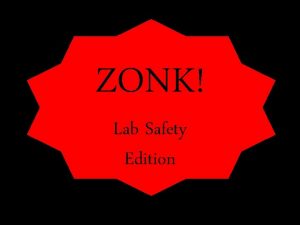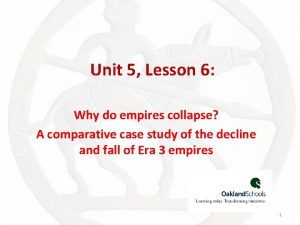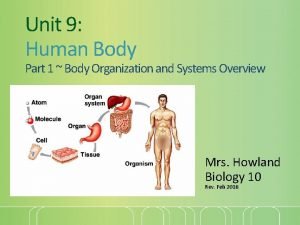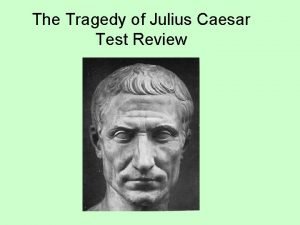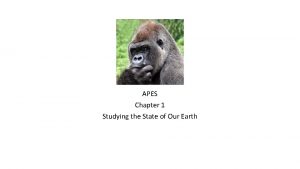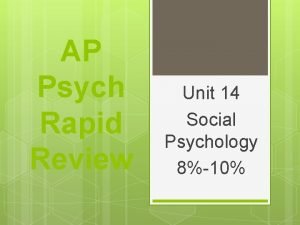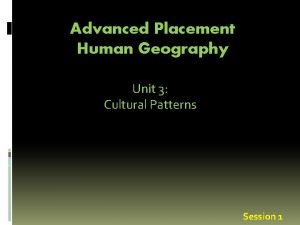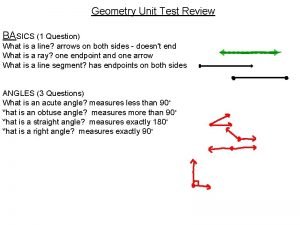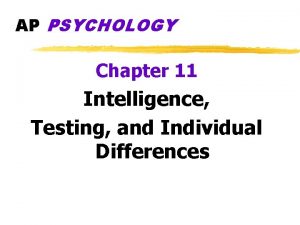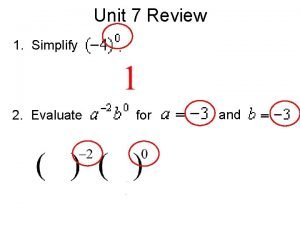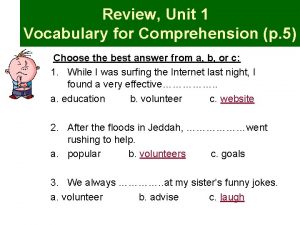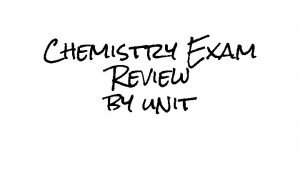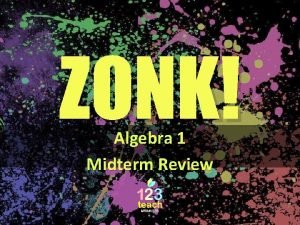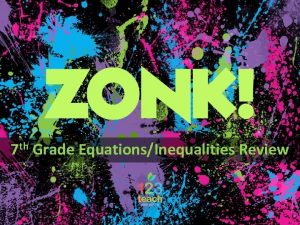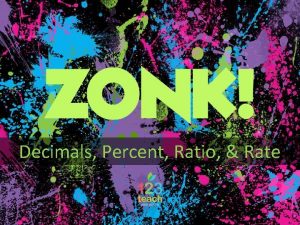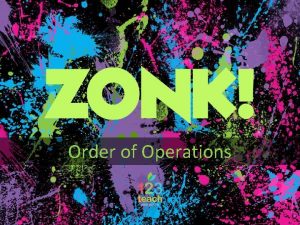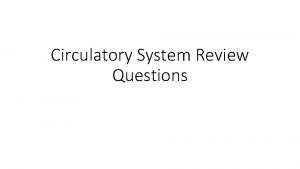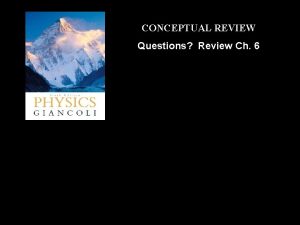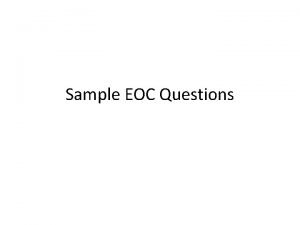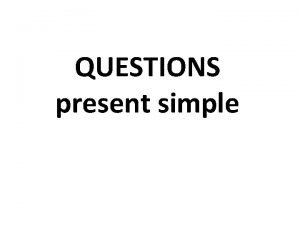Unit V review questions n Zonk q q










































- Slides: 42

Unit V review questions n Zonk – q q q Need 4 groups 1 score keeper Groups who get answers correct have two choices: play the board or pass. 10 zonks on the board Group with most points receives 3 extra credit points on test.

Two closed, pyramid-shaped beakers containing clearly identical amounts of a liquid are suddenly judged by a child to hold different amounts after one of the beakers is inverted. The child apparently lacks a: concept of conservation.

According to Piaget, accommodation refers to: A. B. C. D. parental efforts to include new children in the existing family structure. incorporating new experiences into existing schemas. developmental changes in a child's behavior that facilitate social acceptance by family and peers. adjusting current schemas in order to make sense of new experiences.

Jack is learning to understand algebra. He loves to discuss philosophical issues with his friends, and is exploring various religious beliefs. Jack is in Jean Piaget’s _____ stage. formal operational

After Nadia learned that penguins can't fly, she had to modify her existing concept of birds. This best illustrates the process of: accommodation.

Although 3 -year-old Adam happily explores the attractive toys located in the dentist's waiting room, he periodically returns to his mother's side for brief moments. Adam most clearly displays signs of: A. B. C. D. secure attachment. object permanence. egocentrism. stranger anxiety.

n n By about 8 months, an infant exhibits ______, an awareness that things still exist even when they are out of sight. object permanence

n n One’s ability to reason speedily and abstractly is to _____ intelligence as One’s accumulated knowledge and verbal skills is to _____ intelligence. Fluid intelligence / Crystallized intelligence

n n Piaget maintained that up to about age 6 or 7, children are in a preoperational stage—too young to perform mental operations. They are_______, that is, they cannot perceive things from another’s point of view, and lack a theory of mind. egocentric

n n _______ is the fear of unfamiliar faces that infants commonly display, beginning by about 8 months of age (soon after object permanence emerges). They greet strangers by crying and reaching for their familiar caregivers. Stranger anxiety

n n Erikson theorized eight stages of life, each with its own psychosocial task. for middle-aged adults (forties to sixties), the key conflict is: generativity versus stagnation.

n n The ______ bond is a survival impulse that keeps infants close to their caregivers. Infants become attached to their parents or primary caregivers not simply because they gratify biological needs (nourishment) but because they provide body contact that is soft and warm. attachment

"I don't care whether you want to wash the dishes, you will do so because I said so!" This statement is most representative of a(n) ____ parenting style. authoritarian

According to Erikson, the task of the adolescent is to: establish an identity.

Marissa resents the burden and constraints of caring for her infant daughter and frequently ignores her cries for attention. As a consequence, her daughter is most likely to display insecure attachment. signs of:

• Mr. Bandy’s two-year-old twins are constantly fighting over toys. This behavior is driving Kevin crazy because the twins are hitting each other and pulling toys from each other. He decides to have a talk with them to explain that their behavior has to change. He tells each of them that the other one feels bad when being hit and that they should learn to share. To his dismay, the behavior continued as if he hadn’t done anything. According to Jean Piaget, why might this be happening? Two-year-olds are egocentric and cannot understand things from another’s point of view.

n n The culturally preferred timing of social events such as marriage, parenthood and retirement. Social Clock

Your four-year-old child firmly believes in Santa and has no difficulty in accepting that he comes down the chimney with toys and goodies—despite the fact that your house has no fireplace or chimney. What would Jean Piaget say about this? A. Your child might need some extra help in distinguishing fantasy from reality. B. Your child is acting too young for her age. C. Your child is perfectly normal. D. Your child should be encouraged to reason things out.

n n Erikson theorized eight stages of life, each with its own psychosocial task. Late adulthood’s (late sixties and older) challenge is integrity versus despair.

Your nine-year-old child is fascinated with playing board and card games. He insists on reading all of the rules and following guidelines exactly. What characteristic of the concrete operational stage is he exhibiting? A. B. C. D. The child is exhibiting object permanence. The child is exhibiting conservation of mass. The child is exhibiting reversibility of thinking. The child is exhibiting the increase in logical thinking.

n n By 9 weeks after conception, the embryo looks unmistakably human and is this fetus

n n Substances ingested by the mother can reach the developing child and place it at risk. Teratogens

n n Touched on its cheek, a baby opens its mouth and searches for a nipple Rooting reflex

n n The biological growth processes that enable orderly changes in behavior, sets the basic course of development and experience adjusts it. Maturation

n n concepts or frameworks that organize and interpret information. schemas

n n Familiarity provides another key to attachment. In animals, attachments based on familiarity often form during a critical period shortly after birth. This rigid attachment process is called ______. Although humans do not do this, they do become attached to what they have known. imprinting

n n When placed in a strange situation such as a laboratory playroom, about 60 percent of children display ____; they play comfortably in their mother’s presence, are distressed when she leaves, and seek contact when she returns. secure attachment

n n Erikson attributed the child’s development of _____ a sense that the world is predictable and reliable—to sensitive, loving caregivers. Adult relationships tend to reflect the attachment styles of early childhood. basic trust

n n These types of parents impose rules and expect obedience. Authoritarian

n n Children with the highest self-esteem, selfreliance, and social competence generally have warm, concerned, and these types of parents. authoritative

n n Piaget is to ______ development as Kohlberg is to _______ development as Erikson is to _______ development. Cognitive; Moral; Psycho-social

n n breasts and hips in girls, facial hair and a deepened voice in boys, pubic and underarm hair in both sexes. Secondary sex characteristics

n n The landmarks of puberty are the first ejaculation in boys, which usually occurs by about age 14, and the first menstrual period in girls, usually within a year of age 12. Spermarche / menarche

n n Piaget’s stage where we learn the capacity to reason abstractly. This includes the ability to test hypotheses and deduce conclusions. The new reasoning power is evident in adolescents’ pondering and debating such abstract topics as human nature, good and evil, truth and justice. Formal

n n Lawrence Kohlberg contended that moral thinking likewise proceeds through a series of stages, from a ______ morality of selfinterest, to a ______ morality that cares for others and upholds laws and rules, to (in some people) a ______ morality of agreedupon rights or basic ethical principles. Preconventional / postconvential

n n Erikson theorized eight stages of life, each with its own psychosocial task. In infancy (the first year). Trust vs Mistrust

n n Erikson theorized eight stages of life, each with its own psychosocial task. In toddlerhood (the second year), the challenge is Autonomy vs shame and doubt

n n Erikson theorized eight stages of life, each with its own psychosocial task. Preschoolers (age 3 to 5) learn initiative or guilt,

n n Erikson theorized eight stages of life, each with its own psychosocial task. From elementary school children (age 6 to puberty) develop competence or inferiority.

n n Erikson theorized eight stages of life, each with its own psychosocial task. A chief task of adolescence is to solidify one’s sense of self—one’s identity.

n n Erikson theorized eight stages of life, each with its own psychosocial task. For young adults (twenties to early forties) the issue is intimacy versus isolation

n n a significant physical change of adult life is_____, the ending of the menstrual cycle, which generally seems to be a smooth rather than a rough transition. menopause
 Zonk rules
Zonk rules Unit 6 review questions
Unit 6 review questions Unit test unit test review algebra 2
Unit test unit test review algebra 2 Unit 7: lesson 5 - review questions
Unit 7: lesson 5 - review questions World history unit 5 lesson 6
World history unit 5 lesson 6 H-35 is an orifice gas composed of
H-35 is an orifice gas composed of Unit 41 troubleshooting
Unit 41 troubleshooting Chapter review motion part a vocabulary review answer key
Chapter review motion part a vocabulary review answer key Ap gov final review
Ap gov final review Nader amin-salehi
Nader amin-salehi Example of inclusion and exclusion criteria
Example of inclusion and exclusion criteria Narrative review vs systematic review
Narrative review vs systematic review Unit 9 human body systems review
Unit 9 human body systems review Unit 9 factoring review answers
Unit 9 factoring review answers Unit 8 review geometry
Unit 8 review geometry Unit 8 review logarithms
Unit 8 review logarithms Ap biology unit 2 review
Ap biology unit 2 review Lateral area vs total surface area
Lateral area vs total surface area Chemistry semester 2 review unit 12 thermochemistry
Chemistry semester 2 review unit 12 thermochemistry The tragedy of julius caesar unit test review
The tragedy of julius caesar unit test review Apush review.com
Apush review.com Hamlet unit test
Hamlet unit test Chemistry unit review answer key
Chemistry unit review answer key Geometry unit 5 review
Geometry unit 5 review Apush unit 6 test
Apush unit 6 test Anglicization apush
Anglicization apush Apes unit 1 review
Apes unit 1 review Ap psychology unit 14 review
Ap psychology unit 14 review Unit 2 ap gov review
Unit 2 ap gov review Distance decay ap human geography
Distance decay ap human geography Lesson 3 linear equations in x
Lesson 3 linear equations in x Analytic geometry unit 1 test answers
Analytic geometry unit 1 test answers Flynn effect ap psychology
Flynn effect ap psychology Unit 2 practice test algebra 1
Unit 2 practice test algebra 1 Simplify
Simplify Ap government unit 4 study guide
Ap government unit 4 study guide The crucible unit test review
The crucible unit test review Units 1–3 review: vocabulary for comprehension
Units 1–3 review: vocabulary for comprehension Personal finance unit 1 review
Personal finance unit 1 review Chapter 3 review parallel and perpendicular lines
Chapter 3 review parallel and perpendicular lines Chemistry unit 4 review answer key
Chemistry unit 4 review answer key Unit 6 chemistry review
Unit 6 chemistry review Unit 1 review fundamental economic concepts answers
Unit 1 review fundamental economic concepts answers
